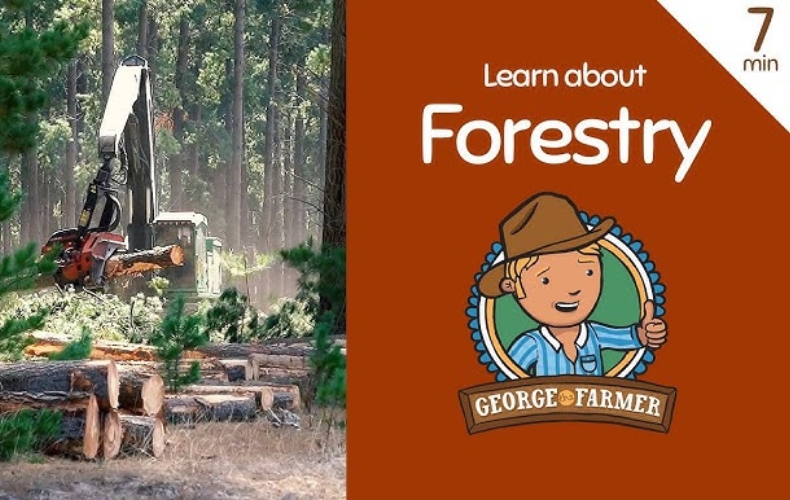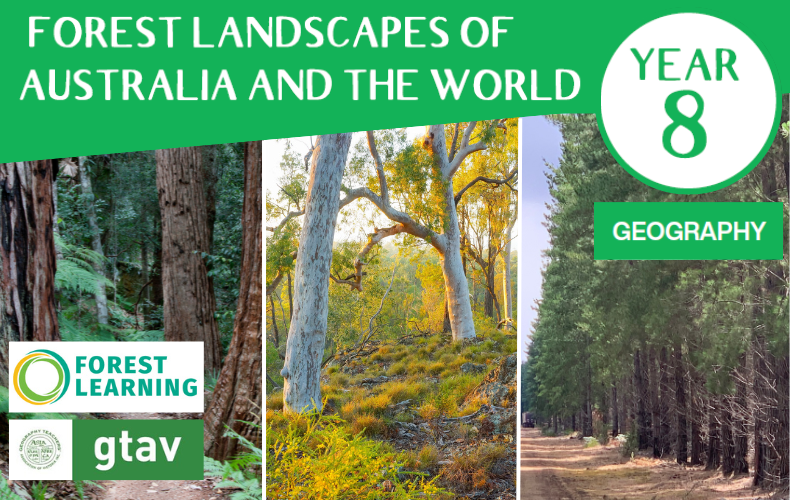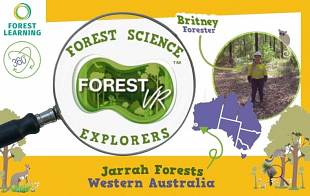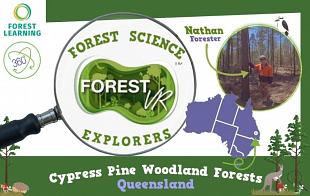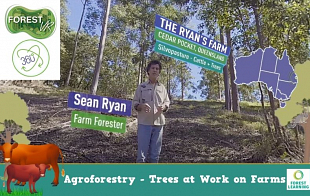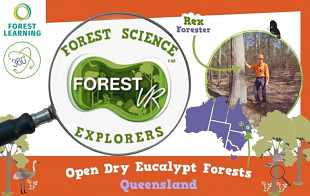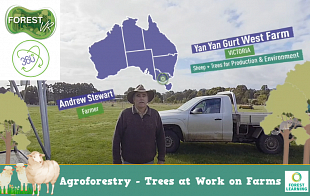GLOSSARY
While undertaking research, you or your students may come across some terms that may need explaining, so we have made it easy for you below.
*FURTHER INFORMATION: The Australian Government Department of Agriculture, Water and the Environment (ABARES) has produced an “Australia’s forests and forestry glossary” (2020) found here –
https://www.agriculture.gov.au/abares/forestsaustralia/glossary
(
(Carbon): Biogenic Carbon
Refers to the carbon removals associated with carbon sequestration into biomass, including natural building materials (e.g., timber) as well as any emissions associated with this sequestered carbon.
A
Adaptation
Modifications in living organisms over time that allow them to function better in their environment.Agriculture
The practice of farming, including cultivation of land for growing crops and livestock production.Agroforestry
Combination of timber production & agriculture on the same land. Farming activities are undertaken between widely spaced trees usually cultivated for timber, firewood and/or fodder.Angiosperms
Flowering plants. These plants produce seeds enclosed in an ovary.Anthropogenic
Relating to or resulting from the influence of human beings on nature.
Aspect
The compass direction towards which a slope faces, for example south-west.Association
A grouping of plants that have similar growing requirements, and are often dominated by one or more species for which they are characterised.B
Backburning
A bushfire preventative technique that involves lighting a controlled fire at a safe point to burn back towards the front of the bushfire. Also see bushfire, controlled burning, wildfire.
Basal area (BA)
The cross-sectional area of a tree at breast height (1.3m) expressed in square metres (m2). It's a tool used to calculate sustainable timber yield.Biodegradable
Material capable of being decomposed e.g. wood.Biodiversity
The genetic variety of life forms and their ecosystems. Comprises genetic diversity (within species), species diversity (between species) and ecosystem diversity. Also see ecosystem.
Bioeconomy
Production of renewable biological resources and their conversion into food, feed, bio-based products and bioenergy.
Bioenergy
Energy generated from biomass, such as electricity or heat.
Biofuel
An alternative fuel that is developed from biological, natural, and renewable sources. Biofuels are an attractive option due to their high energy density and convenient handling and storage properties. Biofuels can be used on their own (with some precautions or restrictions) or blended with petroleum fuels.
Bole
The tree trunk from the ground to the crown break. The bole doesn't include major branches supporting the tree crown, and may/not be straight.Bolewood
Section of the bole that is utilizable for a commercial product and is cut square at both ends to be made ready for delivery for processing.Breast height
1.3m above the ground. This is the standard height at which a tree diameter is measured. Also see basal area, DBH.
Broadleaf forests
The general description of forests composed principally of trees and shrubs of the botanical group of flowering species which is in contrast to conifers or pines.Bushfire
A wildfire burning through bushland such as a State forest. Also see wildfire.
C
Cable logging
Logging method based on a skyline wire cable system, used where slopes are too steep for conventional logging machinery.Canopy
The uppermost level of foliage formed by the branches and leaves of a tree.Capacity
The ability to apply knowledge in problem solving processes and innovate to create change.Captive carbon
Once C02 has been used by a plant the carbon will stay captive (or stored) in the plant until it decomposes, is burnt or breaks down.
Carbon
An element contained in all organic molecules.Carbon Capture and Storage (CCS)
An emerging technology which captures carbon emissions from sources like coal-fired power plants and stores them in geological formations like coal seams, aquifers, and depleted oil and gas reservoirs.
Carbon Capture Capture and Storage (CCS)
Capture and storage of carbon (greenhouse gas) emissions from industrial processes by injecting the captured greenhouse gases back into the ground for permanent storage.
Carbon dioxide (CO2)
A molecule made up of one carbon atom joined to two oxygen atoms. It is a major gas in the Earth's atmosphere. Also see greenhouse gases.
Carbon Footprint
The total carbon emissions caused by an organisation, event or product in a given time frame.
Carbon Neutral / Net Zero
Means there is no net change in carbon dioxide emissions. Carbon neutrality can be achieved by changing an activity so it no longer emits Green House Gases (GHG) or (more typically) by offsetting the GHGs produced.
Carbon Positive
A city, development, building, or product that goes beyond being Carbon Neutral to intentionally remove CO2 from the atmosphere and turns it into useful forms.
Carbon sequestration
The removal and storage of carbon from the atmosphere into natural or man made reservoirs, including forests and wood products.Carbon sink
Carbon sinks are forests and other ecosystems that absorb carbon, thereby removing it from the atmosphere and offsetting CO2 emissions.
Carbon Storage in Timber and Wood Products
Occurs naturally, i.e., in products manufactured from harvested wood such as paper, timber, or panel products or wood in landfill.
Catchment area
A drainage area in the landscape that is the source of water for a river or reservoir. Also see drainage line.
Cellulose
A large molecule made up of glucose units produced naturally by plants. It provides strength to plant cell walls.Certified wood
Certified wood is one where the wood used has been verified as harvested in a sustainable way – including the impact of harvesting on the surrounding environment in terms of protecting the biodiversity of an area, erosion control and preserving water resources. The wood has been certified to a recognised forest certification scheme such as FSC®, PEFC or Responsible Wood.
Chlorophyll
The pigment that gives plants their green colouring. It is required for the absorption of light during photosynthesis.Clearfelling
The lopping and removal of all or most of the tree cover and associated understorey from a forested or vegetated area.Clearing
An area where all or most of the tree cover & associated understorey have been removed & the land use changed eg. for agriculture or urban & industrial development.Climate change
Used to describe changes in the Earth’s climate which can be attributed to human activity (such as burning fossil fuels, clearing vegetation and changing land use) that alters the composition of the global atmosphere and which is in addition to natural climate variability observed over comparable time periods.
Closed forest
A forest with a canopy cover of greater than 70 per cent.Code of forest practice
Legislated rules designed to ensure that commercial timber growing & harvesting is conducted with the environmental values of a forest in mind.Community (ecological)
An ecological unit composed of a group of organisms or a population of different species occupying a particular area usually interacting with each other and their environment.Community (social)
A group of people who live near each other, share common interests, needs and sets of services.Cone
The fruit of coniferous trees that contains the seeds of the plant. Also see conifers.
Conifers
Evergreen trees and shrubs of the botancial group gymnosperms. These plants produce naked seeds usually in cones.Conservation
The management of the natural environment to ensure its survival. A term covering preservation, maintenance, sustainable utilisation, restoration & enhancement of the environment.Conservation for sustainable development
Sustainable development takes account of social & ecological, as well as economic factors & the long & short term advantages & disadvantages of alternative actions.Consumer
Living things that cannot make their own food and have to feed on other living things to survive.
Controlled burning
See hazard reduction burning, backburning, fuel reduction burning, post-logging burning, prescribed burning.
Copice
Regrowth that grows from dormant buds under the bark of tree stumps after the tree has been felled. Eucalypts will copice. Also see lignotuber.
Coupe
A small area of forest within a compartment that is harvested in a single operation.Cross Laminated Timber (CLT)
A solid timber panel produced by bonding together layers of timber with the grain for each layer at a right angle to the grain in adjacent layers. CLT is a ‘whole of structure’ building solution, with similar characteristics to that of a pre-cast concrete panel.
Crown
The top of a tree or group of trees. The leaves and living branches of a tree. Also see canopy.
Crown cover
The area covered by the crowns of trees growing closely together, often expressed as a percentage for the combined crown cover of trees in a defined area.Crown timber lands
Public land for which a jurisdiction maintains the timber rights. For example Forests NSW, Vic Forests.Cultural heritage
Encompasses the qualities & attributes of places that have aesthetic, historic, scientific or social value for past, present or future generations.Cypress pine forest
Softwood conifer forests found in dryer regions of Australia.D
DBH
Abbreviation for the diameter of a tree at breast height (1.3 metres above ground level). Also see basal area.
Deciduous
Plants that shed their leaves annually.Decomposer
Living things such as fungi and bacteria that break down dead organic material (such as leaf litter in the forest).
Decomposer
Name for organisms that break down dead and decaying organisms in the process of decomposition.Deforestation
Clearing of forested areas. Also see clearing, reforestation.
Dicotyledons (dicots)
One of the two sub classes of flowering plants. There are two (di) cotyledons, or seed leaves, present in the seeds of these plants.Dieback
The eventual death of trees from environmental stresses, such as pest attack, exposure to fungal disease, increasing soil salinity & human-induced changes.DNA (Deoxy Ribonucleic Acid)
Spiral chains (double helix) of nucleic acids, joined in pairs that form chromosomes, responsible for carrying the genetic makeup of an organism.Drainage line
A discernible natural depression along which surface water runoff concentrates and flows towards a stream, drainage plain or swamp. Also see filter strip.
Dry sclerophyll forests
Open forests that are found in drier regions, well adapted to fire and low moisture. Leaves are hard textured with fewer pores to minimise water loss.Dryland salinity
Accumulation of salt in soil and water of non-irrigated areas; caused by clearing trees and vegetation on outflow zones for saline water tables.E
Ecologically Sustainable Forest Management (ESFM)
Is the guiding philosophy for forest conservation and management.Ecosystem
Any biological community and its non-living environment, including all the plants and animals in an area together with the air, land and water with which they interact.Ecotourism
Nature-based tourism which is ecologically sustainable.Embodied Carbon
Carbon emissions associated with materials and construction processes throughout the whole lifecycle or a building or infrastructure, excluding operational energy.
Embodied Energy
The total energy necessary for an entire product lifecycle, including both non-renewable and renewable energy.
Emission Factors
Emission factors are used to convert a unit of activity into its emissions equivalent. (e.g., a factor that specifies the kilograms of CO2-eq emissions per unit of activity).
End of Life Carbon
The carbon emissions which occur after an asset’s lifetime – whether associated with deconstruction/demolition, transport from the site, waste processing, or disposal.
Engineered Wood Products
Manufactured composite wood products produced from wood fibres, particles or veneers, and used in a variety of construction and engineering applications. Includes fibreboard (such as medium-density fibreboard, MDF), plywood, cross-laminated timber (CLT) and laminated veneer lumber (LVL).
Environment Product Declaration (EPD)
An independently verified and registered document that communicates transparent and comparable information about the life-cycle environmental impact of products and services in a credible way. An EPD is compliant with the standard ISO 14025 and is a Type III environmental declaration.
Ephemeral stream
A watercourse which flows infrequently.Epicormic growth
Eucalypts are adapted to respond quickly and grow after fire. This growth occurs from epicormic buds that normally lie dormant under the bark until triggered by a fire event.Eucalyptus
A botanical genus (Eucalyptus) of plants, made up of about 700 species; the most important genus of Australian forest trees.Exotic
An introduced species, especially one which is not of Australian origin. Also see Pinus radiata.
F
Farm forestry
Commercial tree production on farmland. Also see agriculture, joint venture.
Fauna
The animal life of a region.Feller buncher
A logging machine that fells trees, de-branches, cuts to length and groups them ready to be removed with a forwarder or skidder.Feral animal
Wild exotic animal. Usually refers to introduced animal species, like foxes, cats and pigs, in Australia.Filter strip
A strip of permanent retained vegetation, 10-50 metres wide, along each side of a drainage line or bank of stream or river for retarding the flow of runoff water.Fire
The active principle of burning or combustion.Fire regime
The fire history or strategy of particular place including the frequency, intensity and season of burning.Flitch
A longitudinal board of timber cut on two or more sides from a log or tree trunk.Flora
The plant life of a region.Forest
An area of land greater than 0.5ha in size, with trees higher than 2 metres and a canopy cover of more than 20 percent; or where trees will mature to these thresholds.Forest Carbon Stock
Forest carbon stock is the amount of carbon that has been sequestered from the atmosphere and is now stored within the forest ecosystem, mainly within living biomass and soil, and to a lesser extent also in dead wood and litter.
Forest products
Raw materials from forests, including timber, timber products and other forest materials (such as rock, stone, clay, sand, gravel).Forester
A forester is a professional person who uses scientific principles to manage forests, engaging in a variety of activities including timber harvesting and wildlife conservation.Fuel load
The amount of fuel available for burning.Fuel reduction burning
See controlled burning.
G
Genus
Scientific class of living things, uniquely named to group species that are very similar to one another and closely related. A sub-division of a family or subfamily.Geographic Information System (GIS)
A computer information technology which stores, analyses and displays geographic data.Global warming
The expected consequence of an increase in the concentration of greenhouse gases by human activity (see greenhouse gases).Glued Laminated Timber (GLT/Glulam)
Glued laminated timber – or glulam – consist of pieces of laminated structural timber that are layered and glued on top of each other in the same direction. This gives GLT increased strength and so it is used mostly in structural beams or columns. GLT can be curved and produced in a variety of shapes, sizes and profiles.
Greenhouse effect
Warming of the Earth's surface due to increases in radiated energy trapped by higher levels of atmospheric gases, including carbon dioxide, due primarily to the combustion of fossil fuels.Greenhouse gases
Atmospheric gases that enhance the natural greenhouse effect, including carbon dioxide, methane, chlorofluorocarbons (CFCs), nitrous oxide, ozone and water vapour.Group selection
Logging process where small groups of mature trees are removed at regular intervals (cutting cycles).Gymnosperms
Non-flowering plants. Seeds not enclosed in an ovary, enclosed in a cone. See cypress, Pinus radiata.
H
Habitat
The native environment where an animal or plant naturally lives or grows.Hardwood
Tree species that have hard and dense wood, and include the eucalypts. Timber from natural hardwood forests is frequently used in hardwood flooring and furniture.Harvesting
The felling of trees, either as a group selection operation or a thinning or a clearfelling operation.
Hazard reduction burning
Burning of accumulated fuels to reduce fire fuel & thereby reduce the risk and impact of wild-fire.I
Integrated harvesting
Removal of more than one product from a forest at the same time, for example both large sawlogs and pulpwood. See harvesting.
Inventory
The process and product of a survey that assesses a resource. May also be termed forest inventory, stand inventory or plantation inventory.Irrigation salinity
Accumulation of salts in the soil.J
Joint venture
In agroforestry, it is typically an enterprise where the farmer provides land and routine maintenance of a stand, while an investor or forest company provide the trees, expertise and marketing opportunities.L
Land capability
The ability of the land to sustain a type and intensity of use without permanent damage.Landing
A selected or prepared area to which logs are hauled for sorting, processing, loading or stockpiling.Leaf
Part of a plant which grows from the stem, makes up the plant's foliage. Photosynthetic organ.Leaf litter
Mixture of fallen and dead plant material on the forest floor, made up of leaves, bark, stems and branches.Life Cycle Assessment or Analysis (LCA)
An analysis of the environmental and/or social impacts of a product, process or a service for its entire life cycle. It looks at the raw material extraction, production, manufacture, distribution, use and disposal of a product.
Lignin
An organic carbon compound found in cell walls of plants. It helps conduct water in living trees and provides structural strength.Lignotuber
Swollen underground root structure developed by most eucalypts, capable of sprouting new shoots if the tree is damaged. Also see copice.
Log
To cut trees into logs; to cut down trees for timber; a portion of cut tree trunk or branch.Log landing
Area where logs are accumulated prior to loading on trucks. See landing.
Logging
The process of cutting down trees for wood. Also see harvesting.
M
Mallee
Dwarf forms of eucalypts that have several stems which grow above ground level from a lignotuber, and generally grow up to ten metres high and on shallow infertile soils.Monocotyledons (monocots)
One of the two sub classes of flowering plants. There is one (mono) cotyledon or seed leaf present in the seeds of these plants.Monoculture
One type or species of plant cultivated in an area, for example plantations of a single species of tree.Multiple use forest management
Forest management of an area for a balanced range of different uses such as wood production, recreation, water catchment protection and flora & fauna preservation.N
National parks
Public forests under management of the federal government where harvesting is excluded. Recreation and biodiversity conservation are the primary goals.Natural resource
These are materials that are obtained from the earth for use by man. For example minerals and forests.O
Old growth forest
Forests in which the upper stratum is ecologically mature and has been subjected to negligible unnatural disturbance such as logging, road building and clearing.Open forest
A forest with a canopy cover of between 30 and 70 per cent.Open woodland
Lightly wooded country, with tree canopy covering an average of less than 10 per cent of the area.Operational Carbon
Green House Gas emissions arising from all energy consumed by an asset in-use, over its life cycle.
Outrow
A row of trees felled in a plantation in order to allow travel of processing, snigging or forwarding machinery in the performance of their functions.Overmature trees
Trees which are well beyond the age of full development and are no longer producing a net growth of wood due to a decline in vigour and health and an increase in decay.P
Parasites
Organisms which obtain their nutrients by feeding off other organisms.Phloem
Part of the plant vascular system where sugars are transported around the parts of a plant.Photosynthesis
The chemical reaction in green plants that uses carbon dioxide, water and sunlight to produce food (glucose).Pine
Any member of the genus Pinus. An evergreen coniferous tree.
Pinus radiata
One species of the genus Pinus. A coniferous tree, native to California. The major source of softwood timber grown in Australia.
Plantation
A forest established by man through planting seedlings or seeds of exotic or native species. They are typically characterised by straight lines and even-aged stands of trees.Post-logging burning
A forest management technique practiced to remove logging debris that could fuel a bushfire. It also stimulates regeneration in the logged area.Prescribed burning
Similar to hazard reduction burning and controlled burning.Producer
Living things such as plants and algae that make their own food, usually using energy from sunlight. Eucalpyt and pine trees that are grown, harvested for wood products, and are again replanted to repeat the cycle are all producers!
Pruning
This is the technique of removing dead, damaged or excess branches from trees. It is usually done from the base of the tree, and encourage trees to grow straight.Pulp
Wood fibre processed to make paper. ‘Pulp’ logs are processed into wood chips or pulp for wood based panels, paper and paper products.Pulpwood
Timber cut and prepared primarily for the manufacture of wood pulp and for further processing to make paper or reconstituted wood product such as fibreboard.Q
Quota
An annual allocation or volume of timber assigned to a forest tenure holder that can be harvested from a particular area. Each log must meet specific criteria, such as size.Quota sawlog
A log having dimensions and quality which are equal to or greater than those specified by agreement. The volume forms part of a sawmill's annual sawlog allocation (quota).R
Radiata pine
Pinus radiata, a coniferous tree, native of California. A major source of softwood timber grown in Australia.Rainforest
Type of forest that grows in higher rainfall regions and in fertile soils. There are both tropical and temperate rainforest in Australia and tend to be protected from harvesting.Reforestation
Replanting of a forest on cleared, degraded or destroyed forest areas.Regeneration
The process of growing new trees on areas previously forested, whether naturally or planted.Regional Forest Agreements (RFAs)
Are 20 year plans for the conservation and sustainable management of Australia’s native forests.Regrowth
A forest stand established by natural regeneration after logging.Remnant vegetation
A small fragmented portion of vegetation remaining after an area has been mainly cleared for human land use.Renewable natural resources
A resource that can be supplied again & again. Forests are a renewable resource, so it is vital they are carefully managed & not over-harvested.Resource
Material required or needed, where stock that can be drawn on. Anything for which there is a perceived present or future use. Can be either renewable or non-renewableResource management
The considered use of renewable and non-renewable resources bearing in mind both the needs of people and the conservation of the resource base for the future.Restoration
Practice of restoring a forest to its previous condition in terms of ecological function and structure as it was prior to disturbance.Root
The part of a plant which grows below the soil surface, repsonsible for anchoring the plant, absorbing nutrients and conducting water.Rotation
The number of years in a production cycle from planting trees till harvest; commonly short rotation hardwood 12-15 yrs, long rotations 25-30 yrs, & softwoods pines 40 yrs.Royalty
A payment made for the value of timber harvested.Runoff
The proportion of rain falling in a catchment which flows across the surface rather than infiltrating the soil. A major cause of soil erosion by water.S
Salvage logging
Logging carried out to use trees that have been damaged by fire or storm.Sawlog
A log of suitable size and straightness, relatively free of internal defects and able to be milled into sections of sawn timber.Seed
The viable part of a plant from which a new plant can grow.Seed orchard
Collection of seed-producing trees; trees cultivated for the production of seeds used to grow and improve tree qualities.Selective logging
Selected trees within an area nominated for logging are logged while other trees are retained to maintain the forest structure & wildlife habitat.Senescent trees
Similar to over-mature trees.Shrub
A woody plant smaller than a tree, usually divided into separate stems near the ground. Also see understorey.
Silviculture
This is a branch of forestry that involves the use of science and art to grow and maintain trees. It involves tree establishment, growth, health and quality.Skidder
A rubber tyred tractor for dragging felled logs to a loading area. Also see feller buncher.
Snig
To haul logs along the ground from tree stump to log landing.Snig track
A track along which logs are snigged, usually from felling point to a nearby log landing.Snigging
The method of removing logs from site after felling operations by dragging.Snigging
The action of chaining a log at stump, then dragging the log along the ground to a landing where it can be loaded on trucks or processed.Softwood
Tree species, including radiate pine and cypress pine, that have soft wood that is useful in making newspapers, toilet paper and tissues as well as house frames and furniture.Stakeholder
An individual that has a specific stake in a given set of resources, and can be affected by decisions of others.Stand
A group (or cluster) of upright trees.State forest
Publically owned forests under state or territory control. Areas of state forests are designated for production where some harvesting occurs.Stem
Part of a plant. A stalk which supports a leaf, flower or fruit.Subtropical
A type of rainforest occurring between the tropics and temperate geographic regions; found between tropic and temperate conditions.Sustainable Forest Management (SFM)
The management of our private & public forests to ensure forests continue to provide a sound supply of renewable timber for present & future generations.Sustainable Yield
Amount of trees removed from a forest must at least equal the amount a forest is able to replace naturally.T
Thinning
A technique to remove thin or weak trees to leave more nutrients and space access for sunlight to the remaining trees to maximise their growth potential and wood properties.Threatened species
A species facing possible extinction if measures are not taken to ensure its survival, such as removing predators and retaining and maintaining its habitat.Timber
The general term used to describe sawn wood suitable for building and other purposes.Total Catchment Management (TCM)
The coordinated and integrated management of natural resources within a catchment area to balance the way resources are used and conserved.Tree
A perennial plant having a self-supporting woody stem or trunk which usually develops woody branches.U
Understorey
The layer of forest vegetation between the overstorey or canopy and the ground layer.Upfront Carbon
The emissions caused in the materials production and construction phases of the lifecycle before the building or infrastructure begins to be used.
Urban forestry
The cultivation and management of trees and forests within cities for their present and potential contribution to the physiological, sociological and economic wellbeing of urban society.V
Value-added
The increased value of a forest product as a result of processing. Producing a product of higher quality and having more monetary value.Visual protection
Strip of forest where harvesting of forest products is minimised in order to maintain views and visual aspects, usually along roadways and scenic lookouts.W
Wet sclerophyll forests
Tall open eucalypt based forests that provide a major source of hardwood timber for processing. They grow very quickly, like fertile soil and high rainfall.Whole of Life Carbon
Whole Life Carbon’ emissions are the sum total of all asset related GHG emissions and removals, both operational and embodied over the life cycle of an asset including its disposal.
Wilderness
An area of land that has been least modified by modern technological society. The most undisturbed expanses of our natural landscapes.Wildfire
A grass or bush fire which burns out of control. A fire which destroys areas of grassland or bush and can destroy buildings and cause the death of vegetation, animals and humans.Wildlife corridor
A strip of vegetation retained between areas of used and unused land to allow wildlife to move from sites of activity to other habitat sites.Windrow
A row of debris collected after the harvesting of a plantation. Debris collected to be burnt to prepare the site for replanting.Wood
The hard, fibrous inner part of tree trunks, branches and stems. Tissue that lies underneath the bark of a plant. A source of timber.Woodland
Plant communities dominated by trees whose crowns shade on average 10 to 30 per cent of the ground. The typical vegetation type in low rainfall and poor soil regions.X
Xylem
The part of a plants vascular system that transports water and minerals within the plant, from the roots to the shoots.Y
Yield
The amount (usually volume) of timber removed annually or periodically from a forest.

